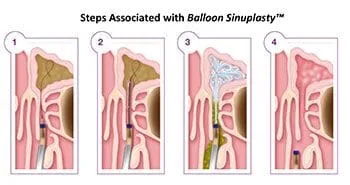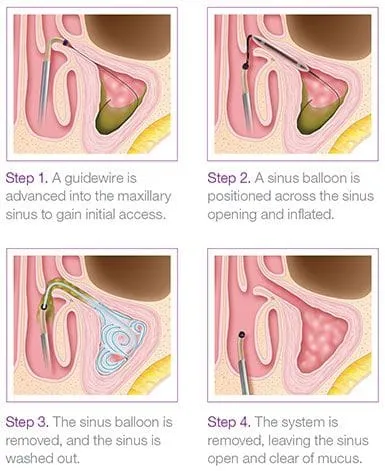
Balloon Sinuplasty is a breakthrough procedure that relieves the pain and pressure associated with chronic sinusitis. It is used by surgeons to safely and effectively treat chronic sinusitis patients who are not responding well to medications such as antibiotics, nasal steroids, or overâ€theâ€counter (OTC) drugs, and are seeking relief from uncomfortable and painful sinusitis symptoms.
Similar to how angioplasty uses balloons to open blocked arteries, Balloon Sinuplasty, a system of FDAâ€cleared, catheterâ€based instruments, opens blocked sinuses.
The procedure is less invasive than traditional sinus surgery. It allows most patients to return to normal activities quickly.1
With Balloon Sinuplasty, a speciallyâ€designed catheter is inserted into the nose to reach the inflamed sinus cavity. A small balloon is slowly inflated, which widens and restructures the walls of the sinus passage, helping to drain mucus from the blocked sinus and restore normal sinus drainage without cutting and with minimal bleeding. This approach also preserves the natural structure of the sinuses.
Published clinical data shows that Balloon Sinuplasty provides symptom relief for the majority of patients:
In the operating room:
- A multiâ€center study of 1,036 patients who had Balloon Sinuplasty reported that sinus symptoms improved in 95 percent of patients at an average followâ€up period of 9 months
- Another multiâ€center study followed 65 patients who had Balloon Sinuplasty and reported clinically and statistically significant improvement in patient symptoms out to two years
In the office:
- Ninetyâ€five percent of patients who have had Balloon Sinuplasty say they would have it again
Balloon Sinuplasty is performed under general anesthesia in an outpatient setting; however, some surgeons are choosing to treat certain patients in their office under local anesthesia. The reported complication rate for Balloon Sinuplasty is low.
Patients who suffer from chronic sinusitis and are not responding well to medications may benefit from seeing an Ear, Nose, and Throat (ENT) physician who performs Balloon Sinuplasty to determine if the procedure is right for them. Most insurance companies and Medicare provide coverage for Balloon Sinuplasty.
Balloon Sinuplasty has been used to treat more than 160,000 patients since receiving FDA clearance.
Chronic sinus infections are inflammations of the sinus lining lasting three months or more. They are most commonly caused by bacterial, viral, and/or microbial infections. Structural issues such as blockage of the sinus opening can also lead to chronic sinus infections. If the opening is closed, normal mucus drainage may not occur. This condition may lead to infection and inflammation of the sinuses.
The following symptoms may indicate a sinus infection in your child:
- A “cold” lasting more than 10 to 14 days, sometimes with low-grade fever
- Thick yellow-green nasal drainage
- Post-nasal drip, sometimes leading to or exhibited as sore throat, cough, bad breath, nausea and/or vomiting
- Headache, usually not before age 6
- Irritability or fatigue
- Swelling around the eyes
What are the treatment options?
Sinus infections are typically treated with medication prescribed by your doctor. However, for some patients medication will not provide symptom relief, and surgery will be recommended.
Balloon Sinuplasty™ Technology is a safe and minimally invasive system that widens the maxillary sinuses in children. It is used as a tool by surgeons in the treatment of chronic sinus infections. Unlike traditional sinus surgery, it does not require bone or tissue removal.
Preliminary results from recent studies indicate that opening a sinus using Balloon Sinuplasty™ Technology in children has an excellent safety profile and may be an effective treatment option for blocked maxillary sinuses.
How does the System work?
The Balloon Sinuplasty™ System uses a small, flexible balloon catheter to gently open the blocked maxillary sinus.

